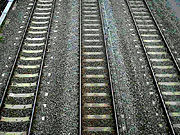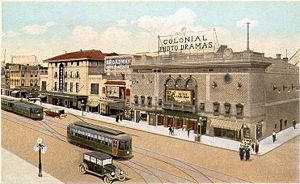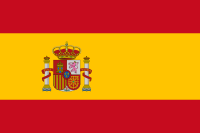Tram
 |
| Rail transport |
|---|
| Operations |
| Stations |
| Trains |
| Locomotives |
| Rolling stock |
| History |
| History by country |
| Terminology |
| By country |
| Accidents |
|
|
A tram, tramcar, trolley, trolley car, or streetcar is a railborne vehicle, of lighter weight and construction than a train, designed for the transport of passengers (and, very occasionally, freight) within, close to, or between villages, towns and/or cities, on tracks running primarily on streets. Melbourne, Australia, currently has the world's largest tram network which is a distinctive feature of the city.
Tramways or street railways were common throughout the industrialised world in the late 19th and early 20th centuries, but they disappeared from many U.S. cities in the mid-20th century. In continental European cities they remained quite common. In recent years, they have made a comeback in many U.S. cities. Many newer light rail systems share features with trams, although a distinction may be drawn between the two, with the term light rail preferred if there is significant off-street running.
Contents |
Etymology

The terms "tram" and "tramway" were originally Scots and Northern English words for the type of truck used in coal mines and the tracks on which they ran—probably derived from the North Sea Germanic word "trame" of unknown origin meaning the "beam or shaft of a barrow or sledge", also "a barrow" or container body.
Although "tram" and "tramway" have been adopted by many languages, they are not used universally in English, North Americans preferring "trolley", "trolley car" or "streetcar". The term "streetcar" is first recorded in 1860, and "trolley" is believed to derive from the "troller", a four-wheeled device that was dragged along dual overhead wires by a cable that connected the troller to the top of the car and collected electrical power from the overhead wires, sometimes simply strung, sometimes on a catenary. The trolley pole, which supplanted the troller early on, is fitted to the top of the car and is spring-loaded in order to keep the trolley wheel or skate, at the top of the pole, firmly in contact with the overhead wire. The terms trolley pole and trolley wheel both derive from the troller.[1]
Modern trolleys often use a metal shoe with a carbon insert instead of a trolley wheel, or have a pantograph. Other streetcars are sometimes called trolleys, even though strictly this may be incorrect: for example, cable cars, or conduit cars that draw power from an underground supply.
Tourist buses made to look like streetcars are sometimes called trolleys in the U.S. (tourist trolley). Open, low-speed segmented vehicles on rubber tires, generally used to ferry tourists short distances, can be called trams, particularly in the U.S.; a famous example is the tram on the Universal Studios backlot tour.
Electric buses, which use twin trolley poles (one for live current, one for return) are called trolleybuses, trackless trolleys (particularly in the U.S.), or sometimes trolleys.
History

The very first tram (streetcar) was the on the Swansea and Mumbles Railway in south Wales, UK); it was horse-drawn at first, and later moved by steam and electric power. The Mumbles Railway Act was passed by the British Parliament in 1804, and the first passenger railway (which acted like streetcars did in the US some 30 years later) started operating in 1807.

The first streetcars, also known as horsecars in North America, were built in the United States and developed from city stagecoach lines and omnibus lines that picked up and dropped off passengers on a regular route without the need to be pre-hired. These trams were an animal railway, usually using horses and sometimes mules to haul the cars, usually two as a team. Rarely other animals were put to use, including humans in emergencies. The first streetcar line—the New York and Harlem Railroad's Fourth Avenue Line—ran along the Bowery and Fourth Avenue in New York City, and began service in 1832. It was followed in 1835 by New Orleans, Louisiana, which is the oldest continuously operating street railway system in the world, according to the American Society of Mechanical Engineers.[2]
The Helsinki tram network is one of the oldest electrified tram networks in the world.
Girder rail
At first the rails protruded above street level, causing accidents and major trouble for pedestrians. They were supplanted in 1852 by grooved rails or girder rails, invented by Alphonse Loubat. The first tram in Paris, France, was inaugurated in 1853 for the World's Fair, where a test line was built along the Cours de la Reine, in the 8th arrondissement. The Toronto streetcar system is one of the few in North America still operating in the classic style on street trackage shared with car traffic, where streetcars stop on demand at frequent stops like buses rather than having fixed stations. Known as Red Rockets due to their color, they have been operating since the mid-19th century - horsecar service started in 1861 and electric service in 1892.
One of the advantages over earlier forms of transit was the low rolling resistance of metal wheels on steel rails, allowing the animals to haul a greater load for a given effort. Problems included the fact that each animal could only work so many hours per day, had to be housed, groomed, fed and cared for day in and day out, and produced prodigious amounts of manure, which the streetcar company had to dispose of. Since a typical horse pulled a car for perhaps a dozen miles a day and worked for four or five hours, many systems needed ten or more horses for each horsecar. Electric trams largely replaced animal power in the late 19th and early 20th centuries. New York City closed its last horsecar line in 1917. The last regular mule drawn streetcar in the U.S., in Sulphur Rock, Arkansas, closed in 1926. During World War II some old horse cars were temporarily returned to service to help conserve fuel. A mule-powered line in Celaya, Mexico, operated until 1956. Horse-drawn trams still operate in Douglas, Isle of Man. There is also a small line on Main Street at DisneyWorld, outside Orlando, Florida. A small horse-drawn service operates every 40 minutes at Victor Harbor, South Australia, daily with 20-minute services during tourist seasons, between the mainland and Granite Island across a causeway.[1]

The tram developed after that in numerous cities, including London, Southampton, Berlin, Paris, Kyoto, Tokyo, Hong Kong and Melbourne. Faster and more comfortable than the omnibus, trams had a high cost of operation because they were pulled by horses. That is why mechanical drives were rapidly developed, with steam power in 1873, and electricity after 1881, when Siemens AG presented the electric drive at the International Electricity Exhibition in Paris.
The convenience and economy of electricity resulted in its rapid adoption once the technical problems of production and transmission of electricity were solved. The first prototype of the electric tram was developed by Russian engineer Fyodor Pirotsky, who modified a horse tram to be powered by electricity. The invention was tested in 1880 in Saint Petersburg, Russia. The world's first electric tram line opened in Lichterfelde near Berlin, Germany, in 1881. It was built by Werner von Siemens (see Berlin Straßenbahn).
In Japan, the Kyoto Electric railroad was the first tram system, starting operation in 1865. By 1932, the network had grown to 82 railway companies in 65 cities, with a total network length of 1,479 km. By the 1960s the tram had generally died out in Japan.
Ireland
From 1898 a tram service was in operation in Cork City in the south of Ireland, however due to increased popularity of buses and rail it was discontinued in 1931. There have been campaigns for the introduction of a service similar to the Luas in Dublin. but so far there has been little support for the idea, as the Bus Eireann service is extremely popular.
Demise in the US
US Auto and tire manufacturers allegedly conspired to close down the US streetcar system in the Great American streetcar scandal.
Demise in the UK
Similar but more subtle pressures and events occurred in the UK.
Britain had the first European trams and until 1935 a large and comprehensive network of systems. For example, it was possible to go by tram across northwest England, from Liverpool to Bolton, using connecting systems. These were mostly closed by a mixture of the same forces as in the US, but with political overtones, since most of the UK systems were municipally owned. The oil and car industries did not like the fact that the municipal tram systems were powered by electricity generated from coal, and to a large extent made car ownership unnecessary.
The 1931 Royal Commission on traffic argued that trams held up cars. When it is realised that there were only one million cars then, what this meant was that trams with poorer people were holding up cars with richer people.
In the UK there was a big public reaction against tramway abandonment, much bigger than the present one against UK Post Office closures, and on a par with the reaction against the Beeching Rail closures in the 1960s, and with the same result. Tram (train) passengers largely did not transfer to the new (flexible and cheaper) buses, but bought cars- resulting in the congested cities in the UK today.
After the war continental countries had little choice but to rebuild their tramways as they could not import oil or rubber but had steel and electricity.
Revival in Europe after 2000
In the last decades, tram networks in countries including France, Spain and Portugal, have grown considerably. The Netherlands has plans to expand trams to two additional cities.[3] Paris reintroduced trams in 2006, and many French cities have seen a similar revival.[4] In Scotland, a system in Edinburgh is under construction.[5] The Czech capital Prague plans one new line and the extension of eight others between 2007 and 2016, with an official of the Prague Public Transport Company stating that "In Europe in the past 10 years, tram transportation is the preferred way of transit; we can say that tram transportation is going through its renaissance period".[6] New technologies, such as electronic display signs at the tram stops and inside the vehicles, and low floors help to make the trams more attractive again.
Types of propulsion
Horse-drawn


In the 19th century Calcutta (now Kolkata) was developing fast as a British trading and business centre. Transport was mainly by palanquins carried on men's shoulders or phaetons pulled by horses. In 1867, the Calcutta Corporation, with financial assistance from the Government of Bengal, developed mass transport. The first tramcar travelled the streets of Calcutta on February 24, 1873, with horse-drawn coaches running on steel rails. The Horse tramcar was a part of (so called) 300 year celebration of Kolkata. It then ran from Binay Badal Dinesh Bag to Rajabazar, mostly following the first horse tram route. The tram was a modified single coach (earlier) electric tram. None of the original horse tram is preserved.
Steam

The first mechanical trams were powered by steam. Generally, there were two types of steam tram. The first and most common had a small steam locomotive (called a tram engine in the UK) at the head of a line of one or more carriages, similar to a small train. Systems with such steam trams included Christchurch, New Zealand; Sydney, Australia; and other city systems in New South Wales.
The other style of steam tram had the steam engine in the body of the tram, referred to as a tram engine. The most notable system to adopt such trams was in Paris. French-designed steam trams also operated in Rockhampton, in the Australian state of Queensland between 1909 and 1939. Stockholm, Sweden, had a steam tram line at the island of Södermalm between 1887 and 1901. A major drawback of this style of tram was the limited space for the engine, so that these trams were usually underpowered.
Cable-pulled
The next type of tram was the cable car, which sought to reduce labor costs and the hardship on animals. Cable cars are pulled along the track by a continuously moving cable running at a constant speed that individual cars grip and release to stop and start. The power to move the cable is provided at a site away from the actual operation. The first cable car line in the United States was tested in San Francisco, California, in 1873. The second city to operate cable trams was Dunedin in New Zealand, from 1881 to 1957.
Cable Cars operated on Highgate Hill in North London and Kennington to Brixton Hill In South London.
Cable cars suffered from high infrastructure costs, since an expensive system of cables, pulleys, stationary engines and vault structures between the rails had to be provided. They also require strength and skill to operate, to avoid obstructions and other cable cars. The cable had to be dropped at particular locations and the cars coast, for example when crossing another cable line. Breaks and frays in the cable, which occurred frequently, required the complete cessation of services over a cable route, while the cable was repaired. After the development of electrically-powered trams, the more costly cable car systems declined rapidly.
Cable cars were especially useful in hilly cities, partially explaining their survival in San Francisco, however, the most extensive cable system in the U.S. was in Chicago, a much flatter city. The largest cable system in the world, in the relatively flat city of Melbourne, Victoria, Australia, had at its peak 592 trams running on 74 kilometres of track.
The San Francisco cable cars, though significantly reduced in number, continue to perform a regular transportation function, in addition to being a tourist attraction. Single lines also survive in Wellington, New Zealand (rebuilt in 1979 as a funicular but still called the "Wellington Cable Car") and Hong Kong.
Electric (trolley cars)

Multiple functioning experimental electric trams were exhibited at the 1884 World Cotton Centennial World's Fair in New Orleans, Louisiana, but they were deemed good enough to replace the Lamm fireless engines then propelling the St. Charles Avenue Streetcar in that city.
Electric trams (trolley cars) were first successfully tested in service in Richmond, Virginia, in 1888, in the Richmond Union Passenger Railway built by Frank J. Sprague. There were earlier commercial installations of electric streetcars, including one in Berlin as early as 1881 by Werner von Siemens and the company that still bears his name, and in Saint Petersburg, Russia, invented and tested by Fyodor Pirotsky in 1880. Another was by John Joseph Wright, brother of the famous mining entrepreneur Whitaker Wright, in Toronto in 1883. The earlier installations proved difficult or unreliable. Siemens’ line, for example, provided power through a live rail and a return rail, like a model train, limiting the voltage that could be used, and providing elecric shocks to people and animals crossing the tracks.[7] Siemens later designed his own method of current collection, from an overhead wire, called the bow collector. and Thorold, Ontario, opened in 1887, and was considered quite successful at the time. While this line proved quite versatile as one of the earliest fully functional electric streetcar installations, it required horse-drawn support while climbing the Niagara Escarpment and for two months of the winter when hydroelectricity was not available. It continued in service in its original form into the 1950s.
The largest tram network in the world is in Melbourne, Victoria, Australia and has 499 trams running on 249 kilometres of track with 1770 tram stops. [8]

Since Sprague's installation was the first to prove successful in all conditions, he is credited with being the inventor of the trolley car. He later developed multiple unit control, first demonstrated in Chicago in 1897, allowing multiple cars to be coupled together and operated by a single motorman. This gave birth to the modern subway train.
Two rare but significant alternatives were conduit current collection, which was widely used in London, Washington, D.C. and New York, and the surface contact collection method, used in Wolverhampton (the Lorain system), Hastings (the Dolter stud system) in the UK, and currently in Bordeaux, France (the ground-level power supply system).
Attempts to use batteries as a source of electricity were made from the 1880s and 1890s, with unsuccessful trials conducted in among other places Bendigo and Adelaide in Australia, and for about 14 years as The Hague accutram of HTM in the Netherlands.

A Welsh example of a tram was usually known as the Mumbles Train, or more formally as the Swansea and Mumbles Railway. Built as the Oystermouth Railway in 1804, on March 25, 1807 it became the first passenger-carrying railway in the world. Converted to an overhead wire system it operated electric cars from March 2, 1929 until its closure on January 5, 1960. These were the largest tram cars built for use in Britain and seated 106 passengers.
Another early tram system operated from 1886 until 1930 in Appleton, Wisconsin, and is notable for being powered by the world's first hydroelectric power station, which began operating on September 30, 1882 as the Appleton Edison Electric Company.
There is one particular hazard associated with trams powered from a trolley off an overhead line. Since the tram relies on contact with the rails for the current return path, a problem arises if the tram is derailed or (more usually) if it halts on a section of track that has been particularly heavily sanded by a previous tram, and the tram loses electrical contact with the rails. In this event, the underframe of the tram, by virtue of a circuit path through ancillary loads (such as saloon lighting), is live at the full supply voltage, typically 600 volts. In British terminology such a tram was said to be ‘grounded’—not to be confused with the US English use of the term, which means the exact opposite. Any person stepping off the tram completed the earth return circuit and could receive a nasty electric shock. In such an event the driver was required to jump off the tram (avoiding simultaneous contact with the tram and the ground) and pull down the trolley before allowing passengers off the tram. Unless derailed, the tram could usually be recovered by running water down the running rails from a point higher than the tram. The water providing a conducting bridge between the tram and the rails.
Other power sources
In some places, other forms of power were used to power the tram. Hastings and some other tramways, for example Stockholms Spårvägar in Sweden, used petrol trams and Lytham St Annes used gas trams. Paris operated trams that were powered by compressed air using the Mekarski system. In New York City some minor lines used storage batteries. Petrol driven tram was also in Karachi.
Sub types
Low floor
-
For more details on this topic, see Low floor.

The latest generation of light rail vehicles is of partial or fully low-floor design, with the floor 300 to 360 mm (12–14 inches) above top of rail, a capability not found in older vehicles. This allows them to load passengers, including in wheelchairs, directly from low-rise platforms that are not much more than raised sidewalks. This satisfies requirements to provide access to disabled passengers without using expensive wheelchair lifts, while at the same time making boarding faster and easier for other passengers.
Various companies have developed particular low floor designs, varying from part low floor, e.g. Citytram [2], to 100% low floor, where a corridor between the drive wheels links each end of the tram. Passengers appreciate the ease of boarding and alighting from low floor trams but for the operator the restrictions of seating layout imposed by 100% designs limits the ability to provide seats, and to vary the configuration for different city needs. There is also some evidence that passengers do not like sitting in low floor areas, especially when trams run in mixed traffic with larger vehicles looming above.
Low floor tram is now running in many cities around the world, like Syndey, Buenos Aires, Istanbul etc.
Articulated

Articulated trams have several sections connected by flexible joints and a round platform. Like articulated buses, they have increased passenger capacity. These trams can be up to 40 metres long, while a regular tram has to be much shorter. With this type, a Jacobs bogie supports the articulation between the two or more carbody sections. An articulated tram may be low floor variety or high (regular) floor variety.
Tram-train
Tram-train operation uses vehicles such as the Flexity Link and Regio-Citadis, which are suited for use on urban tram lines and also meet the necessary indication, power, and strength requirements for operation on main-line railways. This allows passengers to travel from suburban areas into city-centre destinations without having to change from a train to a tram.
It has been primarily developed in Germanic countries, in particular Germany and Switzerland. Karlsruhe is a notable pioneer of the tram-train.
Cargo trams

Goods have been carried on rail vehicles through the streets, particularly near docks and steelworks, since the 19th century (most evident in Weymouth), and some Belgian vicinale routes were used to haul timber. At the turn of the 21st century, a new interest has arisen in using urban tramway systems to transport goods. The motivation now is to reduce air pollution, traffic congestion and damage to road surfaces in city centres. Dresden has a regular CarGoTram service, run by the world's longest tram trainsets (59.4 metres (195 ft)), carrying car parts across the city centre to its Volkswagen factory. Vienna and Zürich use trams as mobile recycling depots. Kislovodsk had a freight-only tram system comprising one line which was used exclusively to deliver bottled Narzan mineral water to the railway station.
In the spring of 2007, Amsterdam piloted a cargo tram operation, aiming to reduce particulate pollution by 20% by halving the number of lorries—currently 5,000—unloading in the inner city during the permitted timeframe from 07:00 till 10:30. The pilot, operated by City Cargo Amsterdam, involved two cargo trams, operating from a distribution centre and delivering to a ‘hub’ where electric trucks delivered to the final destination.
The trial was successful, releasing an intended investment of 100 million euro in a fleet of 52 cargo trams distributing from four peripheral ‘cross docks’ to 15 inner-city hubs by 2012. These specially-built vehicles would be 30 metres long with 12 axles and a payload of 30 tonnes. On weekdays, trams are planned to make 4 deliveries per hour between 7 a.m. and 11 a.m. and two per hour between 11 a.m. and 11 p.m. With each unloading operation taking on average 10 minutes, this means that each site would be active for 40 minutes out of each hour during the morning rush hour.
(References: Samenwest 5 December 2006, NOS3 television news 7 March 2007, Amsterdams Stadblad 4 June 2008)
Pros and cons of tram systems
All transit services involve a tradeoff between speed and frequency of stops. Services that stop frequently have a lower overall speed, and are therefore less attractive for longer trips. Metros, light rail, monorail, and bus rapid transit are all forms of rapid transit — which generally signifies high speed and widely-spaced stops. Trams are a form of local transit, making frequent stops. Thus, the most meaningful comparison of advantages and disadvantages is with other forms of local transit, primarily the local bus.
Advantages
- Multiple entrances allow trams to load faster than suburban coaches, which tend to have a single entrance. This, combined with swifter acceleration and braking, lets trams maintain higher overall speeds than buses, if congestion allows.
- Trams can trackshare with mainline railways, thus able to economically service smaller towns that would be otherwise to expensive to build tram line to. See Karlsruhe Germany; Tam/Train.
- Trams can adapt to the number of passengers by adding additional cars during rush hour (as well as removing excess cars during off-peak hours). No additional driver is then required for the trip in comparison to buses.
- In general, trams provide a higher capacity service than buses.
- Unlike buses, but like trolleybuses, (electric) trams give off no exhaust emissions at point of use. Compared to motorbuses the noise of trams is generally perceived to be less disturbing.
- Rights-of-way for trams are narrower than for buses. This saves valuable space in cities with high population densities and/or narrow streets.
- Because they are rail-bound, trams command more respect from other road users than buses do, when operating on-road. In heavy traffic conditions, rogue drivers are less likely to hold up trams, for example by blocking intersections or parking on the road. This often leads to fewer delays. As a rule, especially in European cities and Melbourne, trams always have priority.
- Emergency services can use tramways to navigate heavy traffic
- Passenger comfort is normally superior to buses because of controlled acceleration and braking and curve easement. Rail transport such as used by trams provides a smoother ride than road use by buses.
- In most countries, trams don't suffer from the image problem that plagues buses. On the contrary, most people associate trams with a positive image. Unlike buses, trams tend to be popular with a wider spectrum of the public, including people of high income who often shun buses. This high level of customer acceptance means higher patronage and greater public support for investment in new tram infrastructure.
- Because the tracks are visible, it is easy for potential riders to know where the routes are.
- Vehicles are running more efficiently and overall operating costs are lower.
- Trams can run on renewable electricity without the need for very expensive and short life batteries [9]
- Consistent market research and experience over the last 50 years in Europe and North America shows that car commuters are willing to transfer some trips to rail-based public transport but not to buses. Typically light rail systems attract between 30 and 40% of their patronage from former car trips. Rapid transit bus systems attract less than 5% of trips from cars, less than the variability of traffic.[10]
Disadvantages
- The capital cost is higher than for buses, hence the usual preference for the latter in smaller cities
- When operated in mixed traffic, trams are more likely to be delayed by disruptions in their lane. Buses, by contrast, can easily manoeuvre around obstacles. Opinions differ about whether deference that drivers show to trams — a cultural issue that varies by country — is sufficient to counteract this disadvantage.
- Tram tracks can be dangerous for cyclists, as bikes, particularly those with narrow tyres, may get their wheels caught in the track grooves. It is also possible to close the grooves of the tracks on critical sections by rubber profiles that are pressed down by the wheelflanges of the passing tram, but cannot be lowered by the weight of a cyclist. However, if not well-maintained, these lose their effectiveness over time. Crossing tracks without trouble requires a sufficient angle of crossing, reducing a cyclists' ability to avoid road hazards where tracks run along the road, especially in wet weather. This and problems with parked cars are lessened by building tracks and platforms in the middle of the road.
- Tram infrastructure occupies urban space above ground and requires modifications to traffic flow.
- Steel wheel trams are noisier than rubber-wheeled trolleybuses when cornering if there are no additional measures taken (e.g. greasing wheelflanges, which is standard in new-built systems).
- Tram drivers can control the switches ahead of them. This caused a major derailment in Geneva, Switzerland. In modern tram systems this problem has been resolved by use of switches that inhibit relocation when a tram is detected passing and/or more sophisticated means of command transmission.
- Light rail vehicles are often heavier per passenger carried than heavy rail and monorail cars, as they must be designed with higher durability (which means more mass) to survive frequent collisions with trucks and automobiles.
- The opening of new tram and light rail systems has sometimes been accompanied by a marked increase in car accidents, as a result of drivers' unfamiliarity with the physics and geometry of trolleys.[11] Though such increases may be temporary, long-term conflicts between motorists and light rail operations can be alleviated by segregating their respective rights-of-way and installing appropriate signage and warning systems.[12]
- Rail transport can expose neighbouring populations to moderate levels of low-frequency noise. However, transportation planners use noise mitigation strategies to minimize these effects.[13] Most of all, the potential for decreased private motor vehicle operations along the trolley's service line due to the service provision could result in lower ambient noise levels than without.
- In the event of a breakdown or accident, or even roadworks and maintenance, a whole section of the tram network can be blocked. Buses and trolleybuses can get past minor blockages quite easily, although trolleybuses are restricted by how far they can go from the wires. Conventional buses can divert around major blockages as well, as can most modern trolleybuses that are fitted with auxiliary engines or traction batteries. The tram blockage problem can be mitigated by providing regular crossovers so a tram can run on the opposite line to pass a blockage, although this can be more difficult when running on road sections shared with other road users. On extensive networks diversionary routes may be available depending on the location of the blockage. Breakdown related problems can be reduced by minimising the situations where a tram would be stuck on route, as well as making it as simple as possible for another tram to rescue a failed one.
Manufacturers




Europe
- Alstom
 France
France - Ansaldobreda
 Italy
Italy - Belkommunmash
 Belarus
Belarus - TRAMKAR
 Bulgaria
Bulgaria - CAF
 Spain
Spain - Crotram
 Croatia
Croatia - Dick, Kerr & Co.
 England
England - Electrometal Timisoara
 Romania
Romania - Ganz
 Hungary
Hungary - Đuro Đaković (factory)
 Croatia (produced trams, 1957–1993)
Croatia (produced trams, 1957–1993) - English Electric Company
 England
England - Firema Trasporti SpA
 Italy
Italy - Inekon
 Czech Republic
Czech Republic - Konstal
 Poland
Poland - queens road works,sheffield eng
PESA Bydgoszcz ![]() Poland
Poland
- RMT Protram
 Poland
Poland - FPS "Cegielski"
 Poland
Poland - RVR (Rīgas Vagonu Rupnīca) (ex—"Fenikss")
 Latvia
Latvia - Siemens
 Germany
Germany - Stadler
 Switzerland
Switzerland - Škoda
 Czech Republic
Czech Republic - ČKD Tatra
 Czech Republic
Czech Republic - TRAM Power Ltd—Citytram
 England
England - Ust-Katav Vagon-Building Plant
 Russia
Russia - U.R.A.C. Bucharest
 Romania
Romania - Uraltransmash
 Russia
Russia - Saint Petersburg Tramway-Mechanical Plant
 Russia
Russia - Yuzhmash
 Ukraine
Ukraine - ZET Zagreb
 Croatia (produced trams, 1922–195x)
Croatia (produced trams, 1922–195x)
North America
- Bombardier Transportation
 Canada
Canada
- Hawker Siddeley Canada 1962–2001
- Urban Transportation Development Corporation 1973–1990s
- Canadian Car and Foundry
 Canada
Canada - J. G. Brill and Company
 United States
United States - American Car Company
 United States
United States - Ottawa Car Company
 Canada
Canada - St. Louis Car Company
 United States
United States - Russell Car Company
 United States
United States - Gomaco Trolley Company TrolleyCar replicas
- Edwards Railcar company TrolleyCar Replicas
- Brookville Equipment company TrolleyCar Replicas
- Transportion Innovations Group TrolleyCar Replicas
- Kasgro Rail Equipment Diesel Electric TrolleyCar Replicas
- Tran Systems Restores Vintage TrolleyCars
Asia and Oceania
- Newstead Tram Cars
 AustraliaTrolleycar Replicas
AustraliaTrolleycar Replicas - Bendigo Tramways
 Australia TrolleyCar Replicas
Australia TrolleyCar Replicas - Commonwealth Engineering
 Australia
Australia - ALNA Sharyo
 Japan
Japan - Kawasaki Heavy Industries
 Japan
Japan - Kinki Sharyo
 Japan
Japan - Niigata Transys Company
 Japan
Japan - Nippon Sharyo
 Japan
Japan - Tokyu Car Corporation
 Japan
Japan - Hong Kong Tramways
 Hong Kong
Hong Kong - Premier Manufacturer
 India
India - Bharat Earth Movers Ltd.
 India
India - Jessop India Ltd.
 India
India
- TDI
In other media
In literature
One of the earliest literary references to trams occurs on the second page of Henry James's novel The Europeans:
- From time to time a strange vehicle drew near to the place where they stood—such a vehicle as the lady at the window, in spite of a considerable acquaintance with human inventions, had never seen before: a huge, low, omnibus, painted in brilliant colours, and decorated apparently with jingling bells, attached to a species of groove in the pavement, through which it was dragged, with a great deal of rumbling, bouncing, and scratching, by a couple of remarkably small horses.
Published in 1878, the novel is set in the 1840s, though horse trams were not introduced in Boston till the 1850s. Note how the tram's efficiency surprises the European visitor; how two "remarkably small" horses sufficed to draw the "huge" tramcar.
Joseph Conrad described Amsterdam's trams in chapter 14 of The Mirror of the Sea (1906): From afar at the end of Tsar Peter Straat, issued in the frosty air the tinkle of bells of the horse tramcars, appearing and disappearing in the opening between the buildings, like little toy carriages harnessed with toy horses and played with by people that appeared no bigger than children.
Danzig trams figure extensively in the early stages of Günter Grass's Die Blechtrommel (The Tin Drum). In the last chapter the novel's hero Oskar Matzerath and his friend Gottfried von Vittlar steal a tram late at night from outside Unterrath depot on the northern edge of Düsseldorf.
It is a surreal journey. Von Vittlar drives the tram through the night, south to Flingern and Haniel and then east to the suburb of Gerresheim. Meanwhile, inside, Matzerath tries to rescue the half-blind Victor Weluhn (who had escaped from the siege of the Polish post office in Danzig at the beginning of the book and of the war) from his two green-hatted would-be executioners. Mazerath deposits his briefcase, which contains Sister Dorotea's severed ring finger in a preserving jar, on the dashboard "where professional motorman put their lunchboxes". They leave the tram at the terminus, and the executioners tie Weluhn to a tree in von Vittlar's mother's garden and prepare to machine-gun him. But Matzerath drums, Weluhn sings, and together they conjure up the Polish cavalry, who spirit both victim and executioners away. Matzerath asks von Vittlar to take his briefcase in the tram to the police HQ in the Fürstenwall, which he does.
The latter part of this route is today served by tram route 703 terminating at Gerresheim Stadtbahn station ("by the glassworks" as Grass notes, referring to the famous glass factory).
[Reference: The chapter Die letzte Straßenbahn oder Anbetung eines Weckglases (The last tram or Adoration of a Preserving Jar). See page 584 of the 1959 Büchergilde Gutenberg German edition and page 571 of the 1961 Secker & Warburg edition, translated into English by Ralph Manheim]
In his 1967 spy thriller An Expensive Place to Die, Len Deighton misidentifies the Flemish coast tram: "The red glow of Ostend is nearer now and yellow trains rattle alongside the motor road and over the bridge by the Royal Yacht Club [3]..." [Chapter 38, page 198 of the Companion Book Club edition.]
In popular culture
- The Rev W. Awdry wrote about GER Class C53 called Toby the Tram Engine, which starred his The Railway Series with his faithful coach, Henrietta.
- A Streetcar Named Desire (play)
- A Streetcar Named Desire (film)
- The children's TV show Mister Rogers’ Neighborhood featured a trolley.
- The central plot of the film Who Framed Roger Rabbit involves the Judge Doom, the villain, dismantling the streetcars of Los Angeles.
- "The Trolley Song" in the film Meet Me in St. Louis received an Academy Award.
- The 1944 World Series was also known as the "Streetcar Series".
- Malcolm (film), an Australian film about a tram enthusiast who uses his inventions to pull off a bank heist.
- Luis Buñuel filmed La Ilusión viaja en tranvía (English: Illusion Travels by Stretcar) in Mexico in 1954.
- In Akira Kurosawa's film Dodesukaden a mentally ill boy pretends to be a tram conductor.
- The predominance of trams (trolleys) gave rise to the disparaging term trolley dodger for residents of the borough of Brooklyn in New York City. That term, shortened to "Dodger" became the nickname for the Brooklyn Dodgers (now the Los Angeles Dodgers).
- Jens Lekman has a song titled "Tram #7 to Heaven".
- The band Beirut has a song titled "Fountains and Tramways" on the album Pompeii.
- The Elephant Will Never Forget, an 11-minute film made in 1953 by British Transport Films to celebrate the London tram network at the time of the last few days of its operation.
- A W-class tram was used at the opening ceremony of the 2006 Commonwealth Games in Melbourne.
In scale modeling
Models of trams are popular in HO scale (1:87) and O scale (1:48) in the US and generally 1:43 in Europe and Asia. They are typically powered and will accept plastic figures inside. Common manufacturers are Roco and Lima, with many custom models being made as well. The German firm Hödl and the Austrian Halling specialize in 1:87 scale.
In the US, Bachmann Industries is a mass supplier of HO trams and kits. Bowser [4] has produced white metal models for over 50 years. There are many boutique vendors offering limited run epoxy and wood models. At the high end are highly detailed brass models which are usually imported from Japan or Korea and can cost in excess of $500. Many of these run on 16.5 mm gauge track, which is incorrect for the representation of standard (4ft 8½ins) gauge, as it represents 4ft 1½ins in 4 mm (1:76.2) scale. This scale/gauge hybrid is called OO scale.
O scale trams are also very popular among tram modelers because the increased size allows for more detail and easier crafting of overhead wiring. In the US these models are usually purchased in epoxy or wood kits and some as brass models. The Saint Petersburg Tram Company [5] produces highly detailed polyeurathane non-powered O Scale models from around the world.
In the US, one of the best resources for model tram enthusiasts is the [6] East Penn Traction Club of Philadelphia.
It is thought that the first example of a working model tramcar in the UK built by an amateur for fun was in 1929, when Frank E. Wilson created a replica of London County Council Tramways E class car 444 in 1:16 scale, which he demonstrated at an early Model Engineer Exhibition. Another of his models was London E/1 1800, which was the only tramway exhibit in the Faraday Memorial Exhibition of 1931. Together with likeminded friends, Frank Wilson went on to found the Tramway & Light Railway Society [7] in 1938, establishing tramway modelling as a hobby.
See also
General
|
|
Types
|
|
Regional
- Trams in Europe
- Trams in Germany
- Trams in Australia
- Trams in Melbourne
References
- ↑ Trolleys or streetcars are generally powered through a single trolley wheel and pole, grounded through the wheels and rails. The motor circuit must be designed to allow electrical current to flow through the underframe.
- ↑ Bellis, Mary. "History of Streetcars and Cable Cars". Retrieved on 2007-01-10.
- ↑ Edo Sturm (2008-02-12). "Steden willen weer terug naar de tram" (in Dutch), Trouw (Netherlands). Retrieved on 2008-08-13.
- ↑ "French rediscover love for streetcars", UPI (Paris) (2008-07-18). Retrieved on 2008-08-13.
- ↑ Fay Winter (2008-08-07). "Tram plans on track for more routes following SNP U-turn", Scotsman. Retrieved on 2008-08-13.
- ↑ Kimberly Ashton (2007-12-05). "Tram service to expand", Prague Post. Retrieved on 2008-08-13.
- ↑ Wood, E. Thomas. "Nashville now and then: From here to there". Retrieved on 2007-08-07.
- ↑ Yarra Trams Tram, tramTRACKER, light rail, Route, Network, City Circle, Love your trams - Facts & Figures
- ↑ Sustainable Light Rail - professor Lewis Lesley. Claverton Energy Group Conference, Bath Oct 2008
- ↑ Sustainable Light Rail - professor Lewis Lesley. Claverton Energy Group Conference, Bath Oct 2008
- ↑ Charles S. McCaleb, Rails, Roads & Runways: The 20-Year Saga of Santa Clara County's Transportation Agency, (San Jose: Santa Clara County Transportation Agency, 1994), 67. Besides recounting statistics and anecdotes, this source also reprints a San Jose Mercury News cartoon of one such accident, in which a bemused tow truck driver quips, "Dang! Rod Diridon was right! The trolley does reduce the number of vehicles on the road!"
- ↑ Transit Cooperative Research Program (TCRP) Report 69: Light Rail Service: Pedestrian and Vehicular Safety, Transportation Research Board http://trb.org/news/blurb_detail.asp?id=2536
- ↑ Transit Cooperative Research Program (TCRP) Report 23: Wheel/Rail Noise Control Manual, Transportation Research Board, http://trb.org/news/blurb_detail.asp?id=2593
External links
- Trolleys of the Future
- 'Tramway' (article in the 1911 Britannica)
- Compressed Air Trams at Tramway & Light Railway Society (UK)
- What is a streetcar? at American Public Transit Association
- Tram Travels (tram enthusiast website providing large number of links and photos)
|
|||||||||||||||||